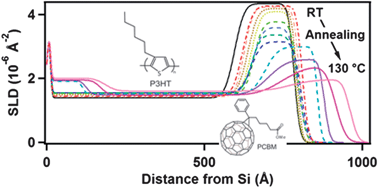Control over the structure of donor/acceptor blends is essential for the development of solution processable organic solar cells (OSCs). We have used time-resolved neutron reflectometry (NR) and in situ annealing to investigate the nanoscale structure and interdiffusion of sequentially spin-coated thin films of poly(3-n-hexylthiophene-2,5-diyl) (P3HT)/[6,6]-phenyl-C61-butyric acid methyl ester (PCBM) and correlated the evolving structure with the device performance. While the as-prepared film shows a clear two-layer structure it is evident that (19 wt%) PCBM has percolated throughout the lower P3HT layer. Upon heating, analysis of time-resolved NR data shows that the diffusion process is dependent on the annealing temperature. At temperatures up to 110 °C, the two-layer structure is retained and only a small amount of PCBM diffuses from the interface into the lower layer, increasing the total PCBM content throughout the P3HT layer to 26 wt%. Significantly, this small change in acceptor content leads to a profound increase in device performance; with the power conversion efficiency (PCE) of the OSCs increasing from 0.47% (unannealed, 19 wt% PCBM) to 3.23% (annealed, 26 wt% PCBM) with the latter showing a similar efficiency to devices prepared from a blend containing 50 wt% PCBM. Further annealing at 120 and 130 °C sees rapid interdiffusion between the two layers, along with an overall expansion in the thickness of the bilayer film. Despite the complete intermixing of the PCBM and P3HT to form a structure resembling a bulk heterojunction, essentially no improvement in device performance was observed for annealing at temperatures above 110 °C.

You have access to this article
 Please wait while we load your content...
Something went wrong. Try again?
Please wait while we load your content...
Something went wrong. Try again?


 Please wait while we load your content...
Please wait while we load your content...